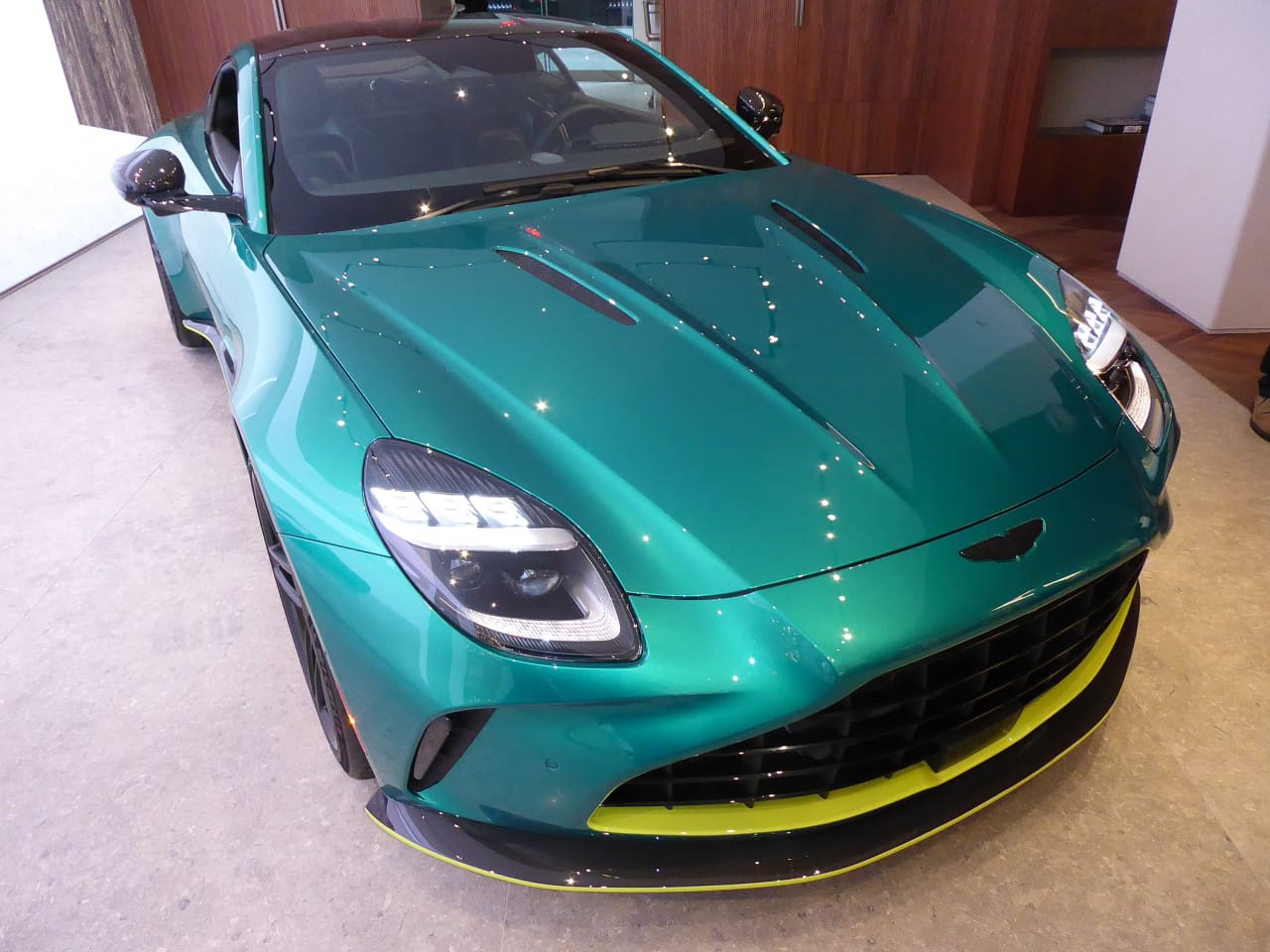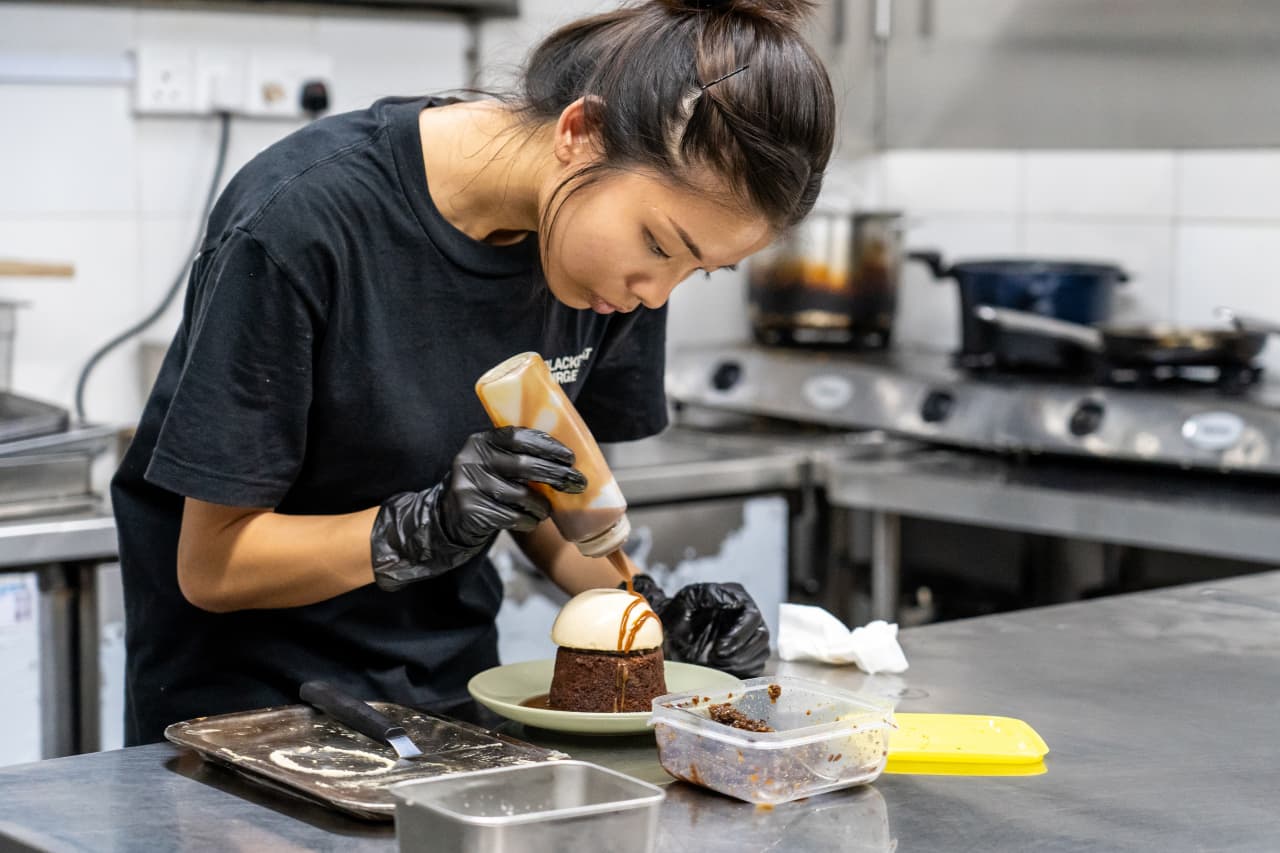It’s impossible to go 202 miles per hour on Manhattan’s Park Avenue (and you shouldn’t try) but that’s where Aston Martin’s opulent showroom is, just down the road from Ferrari. The cars follow the money, and the new Vantage that had its North American debut in New York this month carries a price tag of US$191,000.
Aston is aiming to produce “the definitive front-engine, rear-wheel drive sports car,” powered by a four-litre AMG-sourced twin-turbo V8 engine producing 655 horsepower and 590 pound-feet of torque. Shifting through an eight-speed ZF automatic gearbox (there’s no manual option), it can reach 60 mph in 3.4 seconds. The Vantage can be ordered now, with deliveries this summer.
In other words, the Vantage is a traditional supercar in an age of rapid electrification. There isn’t an auto company in the world that isn’t aware of what’s ahead. And according to Alex Long, who was in New York and heads product and market strategy for Aston, the company is collaborating with California-based Lucid on an electric Aston that will appear in 2026. They’re having the naming discussions now, but few details are available. Lucid, which fields the ultra-fast Air Sapphire , is a pioneer in developing lighter and smaller components for EVs.
The two-seat Vantage has a lot of overlap with the DB12 (a 2+2, meaning it has two decent sized seats in the front and two smaller ones in the back] and it’s a venerable name in the Aston Martin universe, going back 70 years. The new model has been greatly reworked, with modifications to the chassis, engine, body design (the grille is 30% larger), and an all-new interior and bespoke in-house infotainment system with the company’s first touchscreen. Horsepower is up 30% and the torque is up 15%.
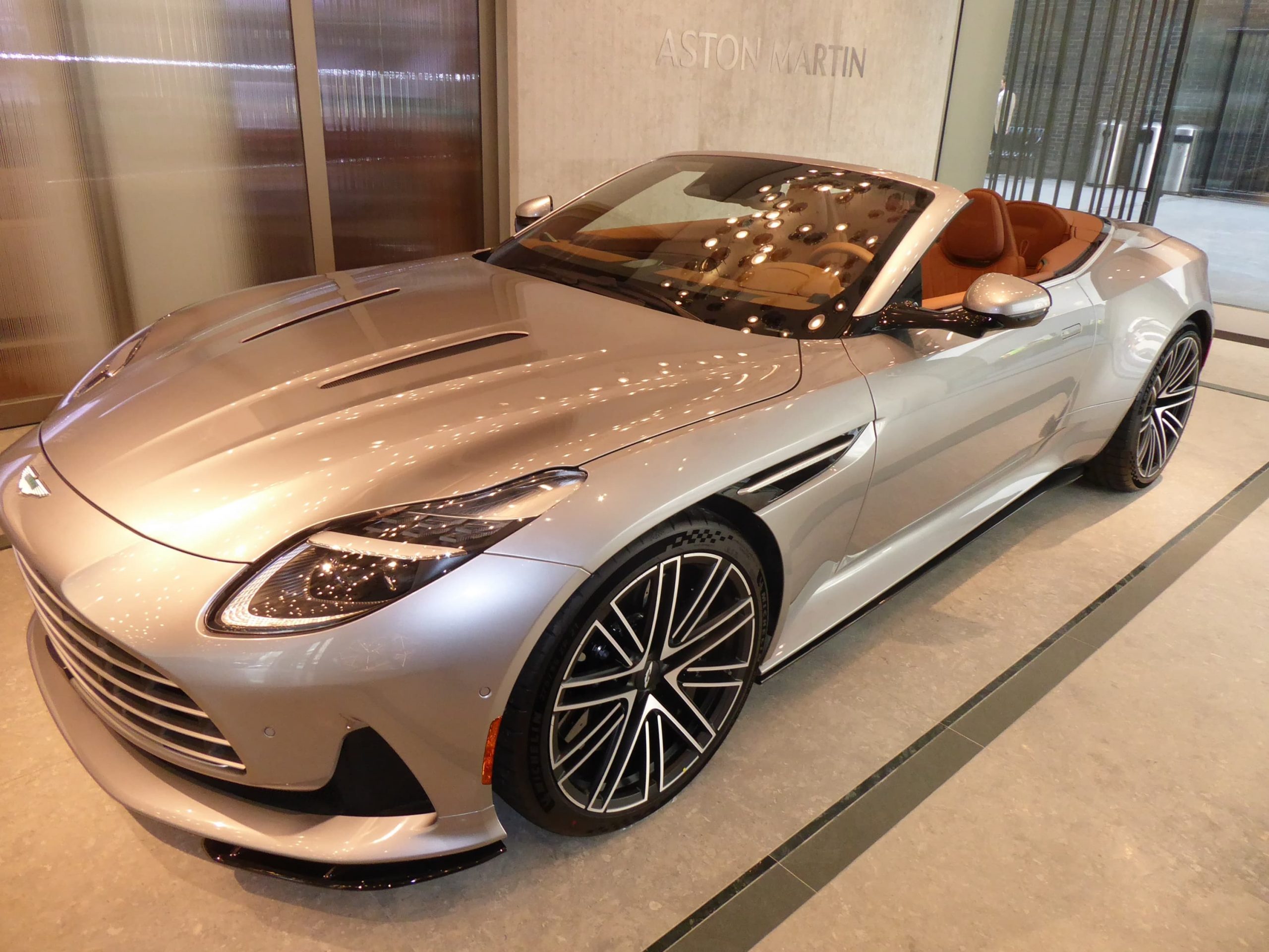
Jim Motavalli
Technical types can thrill to such revelations as “a stiffer-yet-lighter front engine cross brace for increased torsional rigidity and lateral stiffness between the front suspension towers,” as described by Aston Martin.
The new Vantage is indeed techy for an Aston Martin, and offers active vehicle dynamics, adaptive shock absorbers from Bilstein, and an electronic rear differential. There’s a launch control system that manages torque to keep the car planted when it takes off for the horizon.
“[Owner] Lawrence Stroll has made a huge investment in Aston Martin,” Long says. “He believes that in supercar positioning, we have to go all the way.” The Vantage on display was certainly gorgeous in eye-popping Podium Green, which has some blue in it. Apparently the tried-and-true but dark British Racing Green comes off as black in photographs. The vivid green contrasts with a neon-like Lime Essence stripe around the rocker panels and tail.
There was no driving component, but racing driver Darren Turner, a three-time Le Mans winner and an Aston Martin development driver, was on hand.
“I’ve been with the Vantage development program from the beginning,” Turner says. “Our aim with the driving modes [which include Sport, Sport Plus, and Track] was precision behind the wheel.” There’s no “comfort” mode—if you want to commute or buy groceries, you use Sport which, Turner says, “is not too hard on the suspension.”
Long says the Vantage is “practical” because it has a big trunk, but it’s young couples and empty-nesters who won’t mind the absence of a back seat. As for what’s under the hood, Aston’s customers are still thrilling to the sound of a V8 engine and are not pushing for an EV. But with a European ban on internal combustion by 2035, and similar directives in American states, EVs are inevitable under the Aston banner.
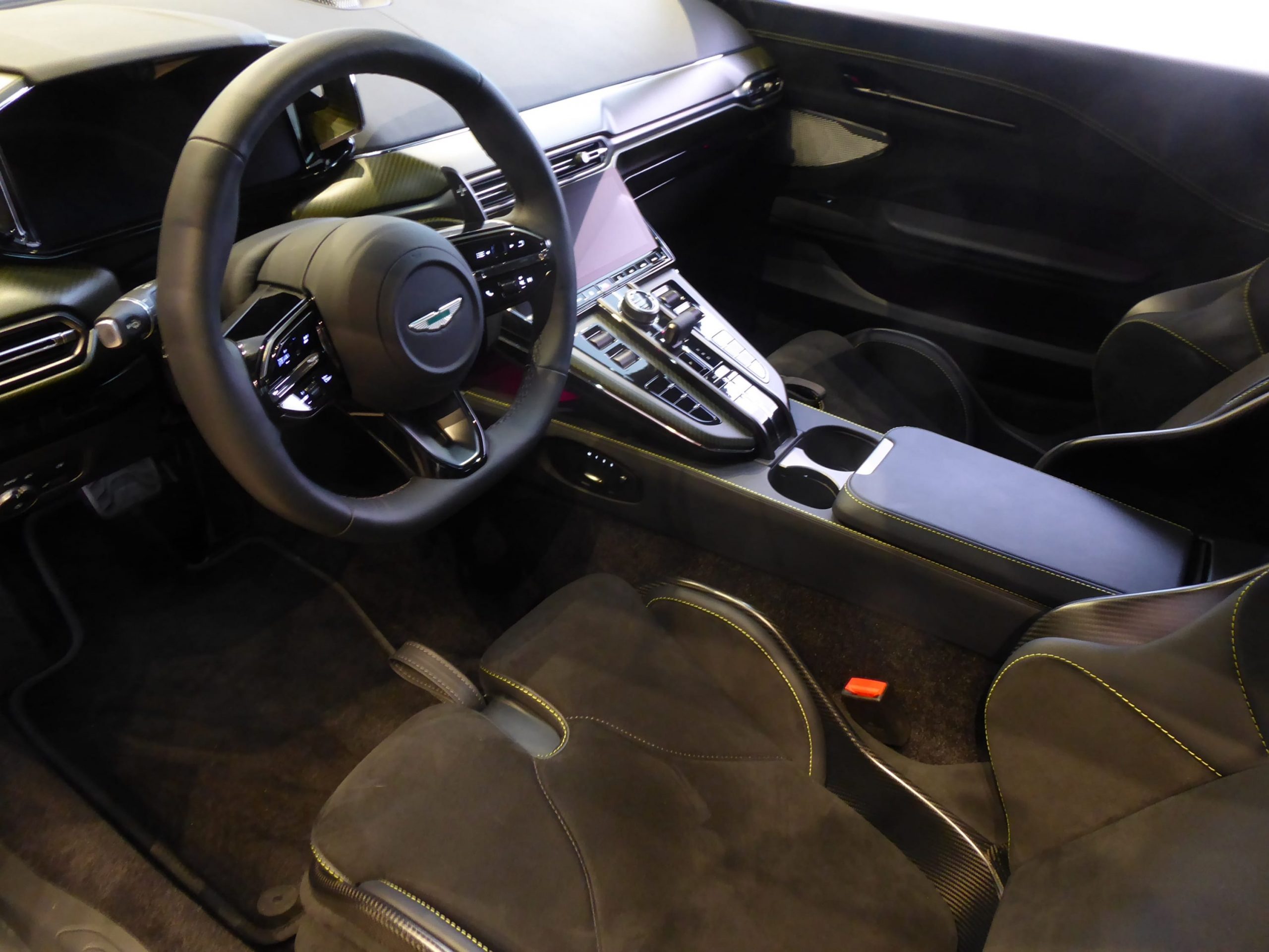
Jim Motavalli
Meanwhile, Aston has other models coming. The ultra-exclusive Cosworth V12-powered Valkyrie (priced at up to US$3.5 million for the track AMR Pro version) will be replaced by the even-more-potent Valhalla at the end of this year. Only 999 Valhallas will be built. The 937-horsepower Valhalla, with an AMG V-8 and two electric motors, will be Aston’s first plug-in hybrid and priced around US$800,000. The Valkyrie was a huge hit in terms of garnering publicity for the brand, and the Valhalla will similarly serve. Just 150 Valkyrie coupes and 85 Spyders are being built, and production should be done by the end of 2024.
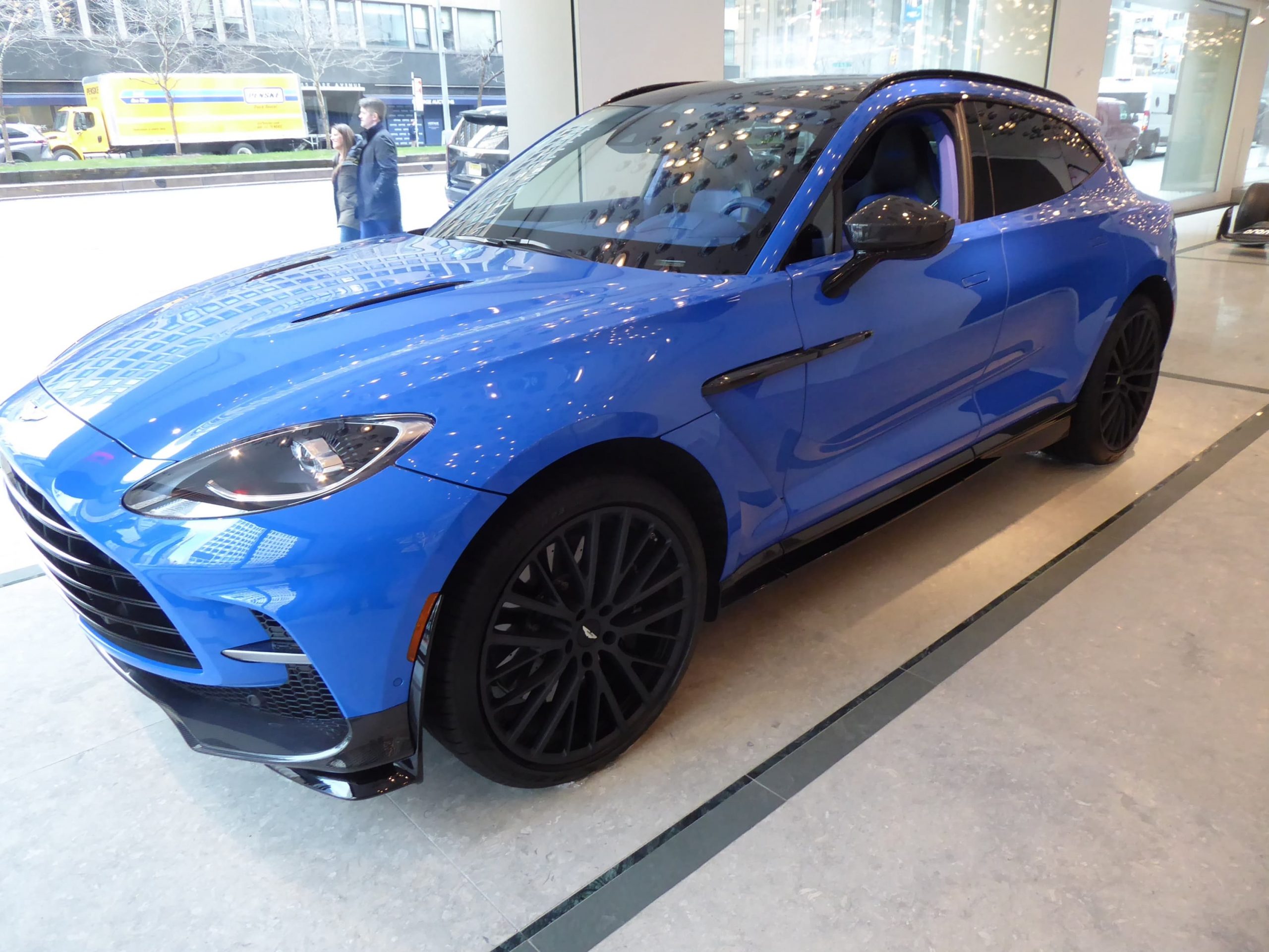
Jim Motavalli
Aston has put considerable effort recently into Formula One and GT racing, and there’s also the Vantage GT4 competition car, which (because of strict rules) shares about 80% of the road car’s structure and mechanicals. But the bonded aluminium chassis gains a custom roll cage.
Aston Martin sold 6,620 cars in 2023. When the company introduced its first SUV, the DBX, it quickly became the company’s runaway bestseller despite a high price tag, now at US$200,086. The DBX 707 (the number is the horsepower rating) ups the ante. SUV leadership is a common result among supercar enterprises that grit their teeth and build SUVs to fulfil consumer demand.
It may be a while before Aston Martin is an all-electric brand. Right now, it’s keeping the order books filled with AMG-powered supercars. But transition is ahead.
 Copyright 2020, Dow Jones & Company, Inc. All Rights Reserved Worldwide. LEARN MORE
Copyright 2020, Dow Jones & Company, Inc. All Rights Reserved Worldwide. LEARN MORE
What a quarter-million dollars gets you in the western capital.
Alexandre de Betak and his wife are focusing on their most personal project yet.
No trip to Singapore is complete without a meal (or 12) at its hawker centers, where stalls sell multicultural dishes from generations-old recipes. But rising costs and demographic change are threatening the beloved tradition.
In Singapore, it’s not unusual for total strangers to ask, “Have you eaten yet?” A greeting akin to “Good morning,” it invariably leads to follow-up questions. What did you eat? Where did you eat it? Was it good? Greeters reserve the right to judge your responses and offer advice, solicited or otherwise, on where you should eat next.
Locals will often joke that gastronomic opinions can make (and break) relationships and that eating is a national pastime. And why wouldn’t it be? In a nexus of colliding cultures—a place where Malays, Indians, Chinese and Europeans have brushed shoulders and shared meals for centuries—the mix of flavours coming out of kitchens in this country is enough to make you believe in world peace.
While Michelin stars spangle Singapore’s restaurant scene , to truly understand the city’s relationship with food, you have to venture to the hawker centres. A core aspect of daily life, hawker centres sprang up in numbers during the 1970s, built by authorities looking to sanitise and formalise the city’s street-food scene. Today, 121 government-run hawker centres feature food stalls that specialise in dishes from the country’s various ethnic groups. In one of the world’s most expensive cities, hawker dishes are shockingly cheap: A full meal can cost as little as $3.
Over the course of many visits to Singapore, I’ve fallen in love with these places—and with the scavenger hunts to find meals I’ll never forget: delicate bowls of laksa noodle soup, where brisk lashes of heat interrupt addictive swirls of umami; impossibly flaky roti prata dipped in curry; the beautiful simplicity of an immaculately roasted duck leg. In a futuristic and at times sterile city, hawker centres throw back to the past and offer a rare glimpse of something human in scale. To an outsider like me, sitting at a table amid the din of the lunch-hour rush can feel like glimpsing the city’s soul through all the concrete and glitz.
So I’ve been alarmed in recent years to hear about the supposed demise of hawker centres. Would-be hawkers have to bid for stalls from the government, and rents are climbing . An upwardly mobile generation doesn’t want to take over from their parents. On a recent trip to Singapore, I enlisted my brother, who lives there, and as we ate our way across the city, we searched for signs of life—and hopefully a peek into what the future holds.
At Amoy Street Food Centre, near the central business district, 32-year-old Kai Jin Thng has done the math. To turn a profit at his stall, Jin’s Noodle , he says, he has to churn out at least 150 $4 bowls of kolo mee , a Malaysian dish featuring savoury pork over a bed of springy noodles, in 120 minutes of lunch service. With his sister as sous-chef, he slings the bowls with frenetic focus.
Thng dropped out of school as a teenager to work in his father’s stall selling wonton mee , a staple noodle dish, and is quick to say no when I ask if he wants his daughter to take over the stall one day.
“The tradition is fading and I believe that in the next 10 or 15 years, it’s only going to get worse,” Thng said. “The new generation prefers to put on their tie and their white collar—nobody really wants to get their hands dirty.”
In 2020, the National Environment Agency , which oversees hawker centres, put the median age of hawkers at 60. When I did encounter younger people like Thng in the trade, I found they persevered out of stubbornness, a desire to innovate on a deep-seated tradition—or some combination of both.
Later that afternoon, looking for a momentary reprieve from Singapore’s crushing humidity, we ducked into Market Street Hawker Centre and bought juice made from fresh calamansi, a small citrus fruit.
Jamilah Beevi, 29, was working the shop with her father, who, at 64, has been a hawker since he was 12. “I originally stepped in out of filial duty,” she said. “But I find it to be really fulfilling work…I see it as a generational shop, so I don’t want to let that die.” When I asked her father when he’d retire, he confidently said he’d hang up his apron next year. “He’s been saying that for many years,” Beevi said, laughing.
More than one Singaporean told me that to truly appreciate what’s at stake in the hawker tradition’s threatened collapse, I’d need to leave the neighbourhoods where most tourists spend their time, and venture to the Heartland, the residential communities outside the central business district. There, hawker centres, often combined with markets, are strategically located near dense housing developments, where they cater to the 77% of Singaporeans who live in government-subsidised apartments.
We ate laksa from a stall at Ghim Moh Market and Food Centre, where families enjoyed their Sunday. At Redhill Food Centre, a similar chorus of chattering voices and clattering cutlery filled the space, as diners lined up for prawn noodles and chicken rice. Near our table, a couple hungrily unwrapped a package of durian, a coveted fruit banned from public transportation and some hotels for its strong aroma. It all seemed like business as usual.
Then we went to Blackgoat . Tucked in a corner of the Jalan Batu housing development, Blackgoat doesn’t look like an average hawker operation. An unusually large staff of six swirled around a stall where Fikri Amin Bin Rohaimi, 24, presided over a fiery grill and a seriously ambitious menu. A veteran of the three-Michelin-star Zén , Rohaimi started selling burgers from his apartment kitchen in 2019, before opening a hawker stall last year. We ordered everything on the menu and enjoyed a feast that would astound had it come out of a fully equipped restaurant kitchen; that it was all made in a 130-square-foot space seemed miraculous.
Mussels swam in a mushroom broth, spiked with Thai basil and chives. Huge, tender tiger prawns were grilled to perfection and smothered in toasted garlic and olive oil. Lamb was coated in a whisper of Sichuan peppercorns; Wagyu beef, in a homemade makrut-lime sauce. Then Ethel Yam, Blackgoat’s pastry chef prepared a date pudding with a mushroom semifreddo and a panna cotta drizzled in chamomile syrup. A group of elderly residents from the nearby towers watched, while sipping tiny glasses of Tiger beer.
Since opening his stall, Rohaimi told me, he’s seen his food referred to as “restaurant-level hawker food,” a categorisation he rejects, feeling it discounts what’s possible at a hawker centre. “If you eat hawker food, you know that it can often be much better than anything at a restaurant.”
He wants to open a restaurant eventually—or, leveraging his in-progress biomedical engineering degree, a food lab. But he sees the modern hawker centre not just as a steppingstone, but a place to experiment. “Because you only have to manage so many things, unlike at a restaurant, a hawker stall right now gives us a kind of limitlessness to try new things,” he said.
Using high-grade Australian beef and employing a whole staff, Rohaimi must charge more than typical hawker stalls, though his food, around $12 per 100 grams of steak, still costs far less than high-end restaurant fare. He’s found that people will pay for quality, he says, even if he first has to convince them to try the food.
At Yishun Park Hawker Centre (now temporarily closed for renovations), Nurl Asyraffie, 33, has encountered a similar dynamic since he started Kerabu by Arang , a stall specialising in “modern Malay food.” The day we came, he was selling ayam percik , a grilled chicken leg smothered in a bewitching turmeric-based marinade. As we ate, a hawker from another stall came over to inquire how much we’d paid. When we said around $10 a plate, she looked skeptical: “At least it’s a lot of food.”
Asyraffie, who opened the stall after a spell in private dining and at big-name restaurants in the region, says he’s used to dubious reactions. “I think the way you get people’s trust is you need to deliver,” he said. “Singapore is a melting pot; we’re used to trying new things, and we will pay for food we think is worth it.” He says a lot of the same older “uncles” who gawked at his prices, are now regulars. “New hawkers like me can fill a gap in the market, slightly higher than your chicken rice, but lower than a restaurant.”
But economics is only half the battle for a new generation of hawkers, says Seng Wun Song, a 64-year-old, semiretired economist who delves into the inner workings of Singapore’s food-and-beverage industry as a hobby. He thinks locals and tourists who come to hawker centers to look for “authentic” Singaporean food need to rethink what that amorphous catchall word really means. What people consider “heritage food,” he explains, is a mix of Malay, Chinese, Indian and European dishes that emerged from the country’s founding. “But Singapore is a trading hub where people come and go, and heritage moves and changes. Hawker food isn’t dying; it’s evolving so that it doesn’t die.”





